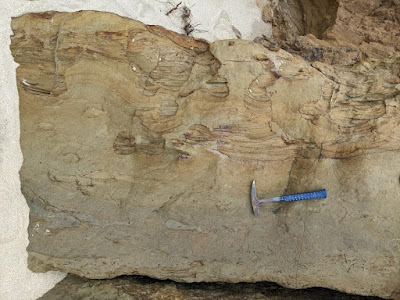It's been a very rough couple of weeks for Sarah and I, so I apologize for being MIA. I'll explain later. But, for the time being, we're back to regular posting.
Sarah below some rather imposing cliffs.
After our marathon day out in Half Moon Bay I realized there were a couple of localities we didn't get to return to, and one specimen in particular that remained uncollected. For some reason I thought that I had first spotted it in fall 2019 and I thought "Oh, I'll come back and collect it in the summer when I have a permit" and then Covid lockdown happened - it did dash my plans for summer fieldwork and I didn't bother applying for a new permit at the time. Going back through my photos, I realized I had actually spotted this fossil in December 2016! I then recalled revisiting the locality several times and failing to re-locate the specimen: a tiny little baleen whale mandible that was perhaps only 4 cm in height, which I figured must have been from a juvenile Herpetocetus - my favorite little dwarf baleen whale. The mandible was eroding out on a bit of a flat bench, so it was at less danger of being washed away - but it was frequently covered with loose bits of rock and dust that fell off the cliff face. On our prior day out there with Jorge Vazquez, Marsha Lidzbarski and Wayne Thompson, I had re-located the specimen - but it was quite a bit further up the cliff face than I had remembered, and I immediately recalled searching the wrong area once I found it. At least a few inches of the specimen had been eroded away forever - a bit of a bummer, but not bad considering I first spotted it seven years prior! I knew from the direction that the mental foramina opened on the side of the mandible that the diagnostic posterior end remained inside the cliff. These foramina (holes) are located on the tooth-bearing part of a regular mammal mandible, but in baleen whales, this part is rib-shaped and of course toothless - and they have more mental foramina than a land mammal, and they have long, anteriorly opening sulci. So - you can immediately tell which direction a mandible is going if you see just a little bit of it. If it's going straight into a cliff, it's a lot more difficult, nigh impossible, to tell.
Sarah and I hiked down the beach and passed a mollusk-bearing bed at the base of the cliff. Sarah froze her ass off the last time we had been out, and I promised her we'd keep today's field trip to about three hours. So, I suggested that she try and collect some mollusks while I dug out the Herpetocetus mandible. I climbed up the ledge and started carving away: the rock was very soft, which made me worry about the integrity of the bone. Earlier collections from this stratum resulted in rather crumbly bone. When I started, I also noticed that the mandible was just beginning to flare out into a ridge - I was pretty sure the coronoid process* of the mandible was present, and complete at that. After a little more digging, I identified the mandibular condyle* and knew that the entire posterior end was fortunately intact.
*The coronoid process is what the temporalis muscle inserts into on the mandible. The condyle is the jaw joint.
The mandible in May 2023, nearly seven years later - at least a few inches had eroded away.
I waved to Sarah, about a hundred yards away, motioning that I was almost done. She returned to the ledge and pulled out a very well-preserved scallop shell that she had expertly collected: I had seen that individual scallop sticking out of the cliff, but left it, since I assumed I would break it. She had collected it in once piece, and even the little ears (auricles) were preserved near the umbo. I was impressed and congratulated her on the find! Such scallops are often crucial index fossils for Neogene fossil localities - though in this case, as covered in the prior post, this section of the Purisima Formation is soon to become the most tightly geochronologically constrained marine section for the Pliocene anywhere on the west coast, to a far greater degree than invertebrates can help.
Excavating the tiny whale jaw from the ledge. Despite the way this photo looks, I'm actually about 20 feet (~7 meters) above the beach here.
Some mollusks from just above the mandible - mostly Anadara trilineata, the common late Miocene-Pliocene ark clam from the west coast.
After a few more minutes of carving a trench into the soft sandstone and outlining a brick-shaped (and sized) block containing the mandible, I stuck my wood chisel horizontally and began to undercut the block with a few gentle taps. The block popped loose rather easily - and then in half, unfortunately. However, it was a very clean fracture, so I wrapped up each block separately with a few sheets of paper towel.












No comments:
Post a Comment